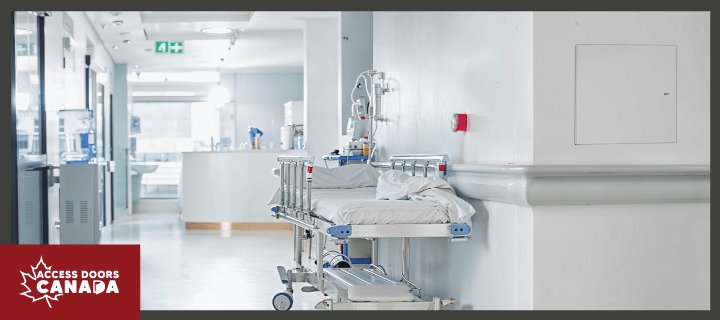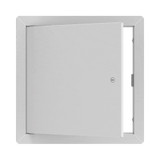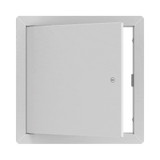What to Look for When Choosing an Access Door for Healthcare Facilities
Despite their unassuming appearance, access doors are essential components of healthcare facilities. They are crucial for preserving a facility's health, safety, and efficiency. The selection of the appropriate access door can impact patient care, staff efficiency, and facility performance.
The Importance of Access Doors in Healthcare Facilities
Access doors provide easy and regulated entry to crucial building elements such as plumbing, electrical systems, and HVAC equipment and access to medical gas lines or communication systems. In healthcare settings, they are particularly important for:
- Ensuring patient safety: Proper access to critical systems is essential for patient care and emergencies.
- Facilitating maintenance: Easy access to equipment reduces downtime and maintenance costs.
- Protecting equipment: Access doors shield valuable equipment from damage and unauthorized access.
Key Considerations When Selecting an Access Door
Several factors, such as the door material, door type, and door hardware, must be considered when selecting access doors for a healthcare facility.
Door Material
Choosing the right material for access doors is crucial for durability, hygiene, and aesthetics. Consider the following:
- Stainless steel: Offers superior durability, hygiene, and corrosion resistance, making it ideal for high-traffic and wet areas.
- Aluminum: Lightweight, corrosion-resistant, easy to clean, suitable for various environments.
- Galvanized steel: Provides good durability and rust protection and is often used in cost-effective solutions.
Door Type
The ideal access door type depends on its specific function and location within the healthcare facility. Consider these options:
- Acoustical: Reduces noise transmission in healthcare facilities, where excessive noise can negatively impact patient recovery and staff satisfaction.
- Airtight/watertight: Prevents air or water infiltration, essential for controlled environments.
- Security: Provides enhanced security features that are suitable for restricted areas.
- Insulated: Maintains temperature and humidity levels, critical for energy efficiency and patient comfort. Examples include the ADC-BAC-ALI aluminum insulated access panel and similar models.
- Heavy-duty: Built for high-traffic areas and heavy equipment access.
Door Hardware
Quality door hardware ensures ease of use, security, and durability. Look for:
- Strong hinges: Ensure the door opens and closes without sagging.
- Secure locks: Protect equipment and prevent unauthorized access.
- Durable handles: Provide a firm grip and resist damage.
Safety and Security Features
Although access doors serve an infrastructure purpose, safety and security are crucial in healthcare facilities. Consider these features:
- Anti-ligature design: Prevents patient self-harm. Recent regulatory changes emphasize the importance of ligature risk mitigation in healthcare facilities to prevent patient self-harm, as suicide is the 10th leading cause of death in the U.S.
- Environmental seals: Maintain proper air pressure and humidity levels.
- Corrosion resistance: Protects the door from damage caused by moisture and chemicals.
Aesthetics and Design
Access doors should integrate with the facility's design. Consider:
- Color matching: Choose a door color that complements the surrounding walls.
- Flush or recessed design: Select a door that minimizes visual impact.
Maintenance and Durability
It is crucial to focus on easy maintenance and long-lasting durability for access doors in healthcare facilities to reduce downtime and maintain operational efficiency. Look for:
- Corrosion-resistant materials: Prevent damage from moisture and cleaning chemicals.
- Smooth surfaces: Help with easy cleaning and disinfection.
- Warranty: Protects against defects and ensures product quality.
Various Applications of Access Doors in Healthcare Settings
To demonstrate how these factors translate into real-world scenarios, let's examine successful access door implementations in various healthcare settings:
- Surgical suites need a sterile environment that allows easy access to essential equipment and utilities. Airtight and watertight access doors constructed from stainless steel provide an effective barrier against contaminants, safeguarding the suite's sterility.
- Intensive Care Units (ICUs) must balance patient privacy with rapid equipment access. Security access doors with restricted entry and soundproofing features protect confidentiality and safety, enabling swift emergency response and incorporating anti-ligature hardware for self-harm protection.
- Radiology departments need frequent equipment access for maintenance and repairs while maintaining a clean environment. Heavy-duty access doors with easy-to-clean surfaces are ideal for this setting. These doors can withstand constant use while preventing bacteria buildup, ensuring operational efficiency and hygiene.
- Pharmacies face the critical challenge of safeguarding medications and controlled substances while ensuring authorized personnel can access them. Security access doors with advanced locking mechanisms safeguard valuable inventory and critical systems.
- Outpatient clinics aim to create a welcoming and efficient environment for patients. Acoustical access doors can contribute to this atmosphere by reducing noise and creating a calmer ambiance. Additionally, flush-mounted doors combine modern aesthetics with practical utility access in the clinic.
Conclusion
Choosing the appropriate access door for a healthcare facility involves considering many factors, such as hygiene, safety, functionality, and aesthetics. Prioritizing hygiene, safety, functionality, and aesthetics ensures that the chosen doors improve the facility's performance and cater to the specific requirements of patients, staff, and equipment.
Are you ready to make an informed decision? Access Doors Canada offers a variety of high-quality options, including the versatile ADC-BAC-ALI aluminum insulated access panel and any surface access doors to suit your needs. Contact our experts today at (800) 679-3405 or request a quote online to find the perfect access doors for your healthcare project.









